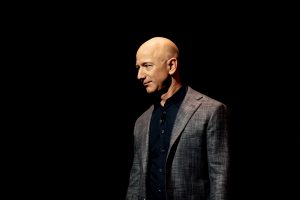8.1 Organizational Environment and Culture
What’s in it for Me?
Reading this chapter will help you do the following:
- Describe what organizational culture is and why it is important for an organization.
- Identify the dimensions that make up a company’s culture.
- Appraise the creation and maintenance of organizational culture.
- Evaluate the factors that create cultural change.
- Identify environmental trends, demands, and opportunities facing organizations.
- Develop personal culture management skills.
Water is invisible to the fish swimming in it, yet it affects their actions; culture consists of unseen elements in organizations, such as assumptions and values, but these aspects affect the behavior of those who exist in that environment. Just as fish must scan their internal and external environments to be aware of what is occurring and to stay on track, businesses must continually do the same.
Example: Exploring Leadership – Jeff Bezos of Amazon

Amazon’s market value was estimated at $1 trillion USD dollars in 2018. The company was recognized as the most innovative company in Fast Company’s 2017 list, accounting for 44 percent of all U.S. e-commerce that year—approximately 4 percent of the U.S.’s total retail sales. Amazon market value is greater than the sum of the market capitalizations of Walmart, Target, Best Buy, Nordstrom, Kohl’s, JCPenney, Sears, and Macy’s. Jeff Bezos, founder and leader, has creatively accomplished what most large companies fail at: meshing size, scale, and external opportunities with agility. Sales figures reached $100 billion in 2015 while the stock price climbed over 300% in the past five years. The company plans on creating over 50,000 new jobs starting in 2018. Bezos has blended his strategy of virtually reaching unlimited numbers of online customers while maintaining land-based distribution centers using Prime’s $99-per-year—$119 in 2018—membership. Stephenie Landry, an Amazon’s vice president, stated that Prime has reached 49 cities in seven countries. Over 100 million people in 2018 subscribe to the Prime service. She noted that the business has only to answer two questions from customers: “Do you have what I want, and can you get it to me when I need it?” The answer seems to be yes, especially with Bezos’s strategy of having high-tech robots already working side by side with human employees—resembling a “factory of the future.”
Bezos’s digital commerce strategy has led the firm to become the leader of retail commerce. Amazon’s digital strategy uses Prime memberships that are supplied and supported by land-based distribution centers; Prime takes in reaching about 60% of the total dollar value of all merchandise sold on the site. That accounts for 60 million customers in the United States who use Prime and who spend $2,500 on Amazon annually. A study of 3,000 independent businesses, half of whom were retailers, listed competition from Amazon as their primary concern. Industry after industry is being disrupted, some replaced, by Bezos’s strategy. He has said, “Everybody wants fast delivery. Low prices. I’m serious about this. Our job is to provide a great customer experience, and that is something that is universally desired all over the world”.
Still, Amazon faces such challenges as high shipping cost (over $11 billion annually), pressures on employees (especially those working in warehouses that have been criticized for poor working conditions), shipping contractors who go on strike demanding higher wages and reduced workloads, and the possibilities of more governmental regulation (especially with regard to adding drones as a delivery method), as well as pressures to pay more taxes. Bezos has countered these arguments by adding more full-time jobs in different cities, promising to improve working conditions, supporting public spaces for the public, and most importantly, contributing to the U.S. economy.
Introduction in Principles of Management by Open Stax is licensed under a Creative Commons Attribution 4.0 International License.
“Organizational Culture” in Principles of Management by University of Minnesota is licensed under a Creative Commons Attribution-NonCommercial-ShareAlike 4.0 International License, except where otherwise noted.

